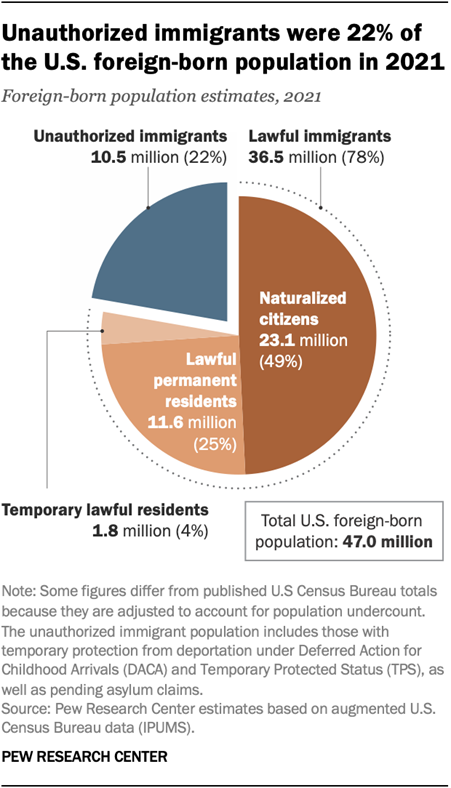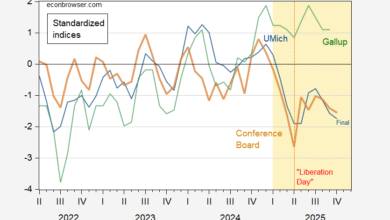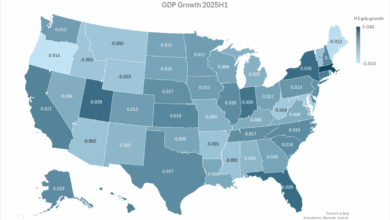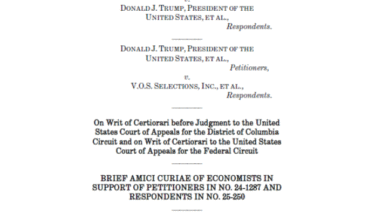
For whom the bell tolls? Undocumented? Documented but not naturalized? All non-native born? Native born with both parents undocumented?

People hold signs that read, “Mass Deportation Now!” on the third day of the Republican National Convention at the Fiserv Forum on July 17, 2024, in Milwaukee, Wisconsin. Delegates, politicians, and the Republican faithful are in Milwaukee for the annual convention, concluding with former President Donald Trump accepting his party’s presidential nomination. The RNC takes place from July 15-18. (Photo by Alex Wong/Getty Images)
Source: FoxNews.
From FoxNews:
Calls for additional border security and mass deportation of illegal immigrants were again on display at the Republican National Convention’s third night, as the ongoing crisis at the border remains a top political issue.
How many individuals need to be deported to fulfill this objective? According to Pew, in 2021, about 10.5 million.
Source: Pew.
DHS has recently calculated the number of unauthorized immigrants (as a residual of foreign born citizens and legal residents) at 11 million. This is around 3.3% of the US population.
A Forbes article notes:
According to Charlie Savage, Maggie Haberman and Jonathan Swan, “He plans to scour the country for unauthorized immigrants and deport people by the millions per year.” The idea is to use local police and National Guard from states with Republican governors.
“To ease the strain on ICE [Immigration and Customs Enforcement] detention facilities, Mr. Trump wants to build huge camps to detain people while their cases are processed and they await deportation flights,” reports the New York Times. “And to get around any refusal by Congress to appropriate the necessary funds, Mr. Trump would redirect money in the military budget, as he did in his first term to spend more on a border wall than Congress had authorized.”
To the extent concentration of detained individuals in centralized facilities (aka, “Konzentrationslager”) could reduce per unit costs of mass incarceration, this approach makes a sort of accounting sense. Nonetheless, I assume there will be some fiscal implications of such a policy, both in increasing costs (note Mr. Trump has suggested use of armed forces and national guard in pursuit of this policy), taking care of American-born dependents of unauthorized immigrants deported, and in decreasing tax revenues.
In the larger macroeconomic context, such a policy would be disastrous, leading to a major disruption in the labor market. From Shapiro/Washington Monthly:
By any measure, a policy that eliminated 4.5 percent of the current workforce, including large numbers of college and high school graduates, would set off serious economic tremors. Using Okun’s Law on the relationship between rising unemployment and GDP, a 4.5 percent drop in employment is associated with depressing GDP growth by more than 9 percentage points. This estimate also includes the impact on other jobs. A recent study of much more modest programs to deport immigrants found clear evidence that they cost other American jobs. By one calculation, deporting 1 million immigrants would lead to 88,000 additional employment losses by other Americans, suggesting that Trump’s program could cost up to 968,000 Americans their jobs on top of the 7.1 million jobs held by immigrants up for deportation.
I’m not too keen on using Okun’s Law to infer the short-run GDP drop, but to the extent that there are large complementarities (i.e. little substitutability) between unauthorized immigrant labor and native born labor (there is greater substitutability between incoming and incumbent non-native born labor), one could trace out the macro implications using a simple AD-AS model. The mass deportation policy would act as (1) reducing potential GDP by reducing the labor force, (2) reducing aggregate demand by reducing consumption, (3) inducing a temporary cost-push shock as labor has to be re-allocated (similar to the 2018-2020 labor crunch), and (4) raising economic policy uncertainty, thereby depressing aggregate economic activity and particularly investment.
In essence, this policy outcome would be a small bore version (in reverse) of the effects of immigration increase in 2021 onward, discussed in this post.
For more recent and detailed analyses of substitutability and employment/wage changes due to immigration, see Caiumi and Peri (2024).
The above discussion incorporates number for unauthorized immigrants as currently defined. I have not considered numbers implied if birthright citizenship, as advocated by Mr. Trump in 2023, is used for the deportation criteria.
Source link





